
Shanghai Expo 2010
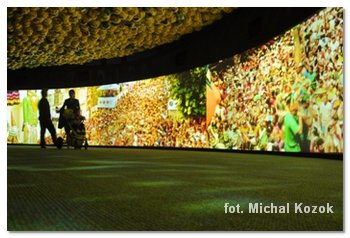 Since 1st May till 31st October 2010, Shanghai is hosting the international exposition EXPO 2010. It aims to present innovative solutions, technology, architecture, urban, ecology, etc. This year the exhibition theme is "Better city, better life". Most of the world's countries built their pavilions there, which presents its ideas.
Since 1st May till 31st October 2010, Shanghai is hosting the international exposition EXPO 2010. It aims to present innovative solutions, technology, architecture, urban, ecology, etc. This year the exhibition theme is "Better city, better life". Most of the world's countries built their pavilions there, which presents its ideas.
We had the only one day ticket. It's far not enough - for 13 hours of intensive running in the complex we saw 30 pavilions. We have feeling that we missed the second day of sightseeing, or three less intense days would be fine as well. But what we saw will remain for long in our memories - some ideas are simply human genius or the amazing possibilities of modern technology. Expo 2010 is expecting approximately 100 million visitors, so it's not hard to imagine a huge crowd interesting in this exhibition.
 We had skipped the host pavilion, because first you have to spend several hours waiting for reservation, and then again unspecified queuing time to get inside. Fortunately, only the Chinese pavilion require such a procedure, the rest you can visit just after waiting in one queue. The queue is big only to the most popular pavilions, so if you want to avoid it, just come on working day (not on weekend), and during the biggest traffic (from noon till 6 pm) visit the less popular pavilions, which has no such big queues. In morning and evening wait to enter the most popular presentations, the queues should be already much smaller (for us the maximum time of queuing was 30 minutes).
We had skipped the host pavilion, because first you have to spend several hours waiting for reservation, and then again unspecified queuing time to get inside. Fortunately, only the Chinese pavilion require such a procedure, the rest you can visit just after waiting in one queue. The queue is big only to the most popular pavilions, so if you want to avoid it, just come on working day (not on weekend), and during the biggest traffic (from noon till 6 pm) visit the less popular pavilions, which has no such big queues. In morning and evening wait to enter the most popular presentations, the queues should be already much smaller (for us the maximum time of queuing was 30 minutes).
We visited the EXPO in the fifth day after the opening day, so we had no information where visiting is worth it, and where it is the time wasting. In our case of one-day visit, it is considerable important, if I had a three-day ticket I would visit most of the pavilions, as the recommendations could be very individual, depending on the specific tastes and expectations. A lot also depends on perception, it is easy to miss some detail, which might be important. Below I write my point of view, assuming that the most important for me is the original idea and its skilful presentation.
 The most we liked the Chilean pavilion. Good presentation of city's image before and after the earthquake, a skyscraper's windows view where you can spy daily people lives. In addition, there was a tree trunk where you could hear different sounds from all over Chile; and interactive map, showing different regions of the country. Also they “dug a well" where in the screen you could see people sitting in a cafe in Santiago (Chile is right across the globe). They had a nice staff, pavilion was wooden, you could taste a wine, etc. all together have contributed the positive impression. Also on the top list I would put Brazilian pavilion, where they showed, in an interesting way on four opposite screens, the daily routine of four different people. In addition, they beamed on the floor satellite pictures of Brazilian cities, combining interactive human figures, a good country presentation on energetic film with loud music. Spanish pavilion showed the movie linking the old and modern times. This extremely interesting composition was shown on several screens hung asymmetrically. In addition, in one dark room there was a "thunderstorm", illuminate flashes of thunder and the graceful dancer which a bit embarrassed the Chinese audience.
The most we liked the Chilean pavilion. Good presentation of city's image before and after the earthquake, a skyscraper's windows view where you can spy daily people lives. In addition, there was a tree trunk where you could hear different sounds from all over Chile; and interactive map, showing different regions of the country. Also they “dug a well" where in the screen you could see people sitting in a cafe in Santiago (Chile is right across the globe). They had a nice staff, pavilion was wooden, you could taste a wine, etc. all together have contributed the positive impression. Also on the top list I would put Brazilian pavilion, where they showed, in an interesting way on four opposite screens, the daily routine of four different people. In addition, they beamed on the floor satellite pictures of Brazilian cities, combining interactive human figures, a good country presentation on energetic film with loud music. Spanish pavilion showed the movie linking the old and modern times. This extremely interesting composition was shown on several screens hung asymmetrically. In addition, in one dark room there was a "thunderstorm", illuminate flashes of thunder and the graceful dancer which a bit embarrassed the Chinese audience.
 Good movies presentations we have seen also in the United Arab Emirates pavilion, which showed the development of the country from the desert oasis to modern metropolis. The Belgian pavilion has showed a variety topics in different European Union countries. We could see at one time the different cyclists passing through the different capitals, the same thing with the city metro, people walking in the parks, talking, having a lunch in restaurants, etc. However, the most interesting and original architectural solution has showed United Kingdom – the structure design which consisted 60,000 thin transparent acrylic tube, each 6-meter long, and at the end of every single tube there were placed seeds from around the globe. These tubes were connected with strings, they optically created several meters high lump of earth shape, but really it doesn't have the walls. If you cut the cords, all structure would collapse.
Good movies presentations we have seen also in the United Arab Emirates pavilion, which showed the development of the country from the desert oasis to modern metropolis. The Belgian pavilion has showed a variety topics in different European Union countries. We could see at one time the different cyclists passing through the different capitals, the same thing with the city metro, people walking in the parks, talking, having a lunch in restaurants, etc. However, the most interesting and original architectural solution has showed United Kingdom – the structure design which consisted 60,000 thin transparent acrylic tube, each 6-meter long, and at the end of every single tube there were placed seeds from around the globe. These tubes were connected with strings, they optically created several meters high lump of earth shape, but really it doesn't have the walls. If you cut the cords, all structure would collapse.
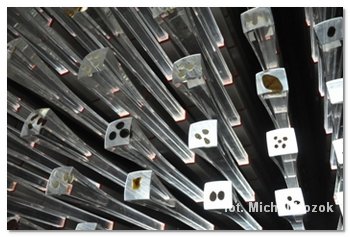 In contrast, we have seen as well other countries pavilions which hadn't prepared an interesting exhibition. Their presentations room looked more like advertising on a tourist fair trade, with posters, brochures, etc. Sometimes there were a visual presentation, but it was just a screen with such presentations, what you can find yourself on internet - there was lack of initiative, idea, character. There is a list of countries pavilions, which totally disappointed us: Yemen, Iran, Nepal, Argentina, Peru, South Africa, Denmark, Finland, and all joint pavilions such as the Caribbean, Africa, etc. And I didn't understand the laser show in India pavilion, which was all in Chinese!? Moreover, a similar attitude, good technique and technology, but the content was addressed to the Chinese audience, not to the world, presented Russia and Australia. Poland has a brilliant pavilion from outside, but inside the disorganization had faded our enthusiasm.
In contrast, we have seen as well other countries pavilions which hadn't prepared an interesting exhibition. Their presentations room looked more like advertising on a tourist fair trade, with posters, brochures, etc. Sometimes there were a visual presentation, but it was just a screen with such presentations, what you can find yourself on internet - there was lack of initiative, idea, character. There is a list of countries pavilions, which totally disappointed us: Yemen, Iran, Nepal, Argentina, Peru, South Africa, Denmark, Finland, and all joint pavilions such as the Caribbean, Africa, etc. And I didn't understand the laser show in India pavilion, which was all in Chinese!? Moreover, a similar attitude, good technique and technology, but the content was addressed to the Chinese audience, not to the world, presented Russia and Australia. Poland has a brilliant pavilion from outside, but inside the disorganization had faded our enthusiasm.
In some way interesting presentations we have seen in the following pavilions: Canada, France, Italy, Sweden, Switzerland, USA, Colombia, Angola and Iceland. Many other we just had no time to visit.
The exhibition will be finished in October 2010, in general, the buildings will be destroyed. Although not always the host has done it. For example, after the Paris EXPO exhibition in 1889, it was decided not to disassemble the Eiffel Tower, which was a symbol of the power of modern France.
![]()
Shanghai
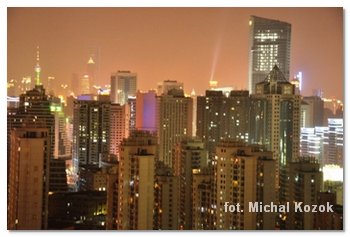 China has 122 cities over one-million population. Among these metropolis, Shanghai is the biggest. But not the size impressed me so much, though it also had a part of it. The city amazed me with mixing modernity with tradition, the development of technology and progress, while typical Chinese mess is still on. Shanghai deserves to be called the world's metropolis, where the international venues like music concerts, sport events, exhibitions, performances, conferences, etc. are hold. I went there with a book guide from 2005, on the map I had marked two metro lines. Currently, just five years later, there are already 11 modern metro lines. I'm pretty sure that Sydney could be envy for such technologies.
China has 122 cities over one-million population. Among these metropolis, Shanghai is the biggest. But not the size impressed me so much, though it also had a part of it. The city amazed me with mixing modernity with tradition, the development of technology and progress, while typical Chinese mess is still on. Shanghai deserves to be called the world's metropolis, where the international venues like music concerts, sport events, exhibitions, performances, conferences, etc. are hold. I went there with a book guide from 2005, on the map I had marked two metro lines. Currently, just five years later, there are already 11 modern metro lines. I'm pretty sure that Sydney could be envy for such technologies.
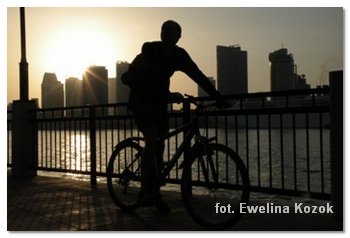 We had met our couchsurfing hosts, so we could see the different districts of the city, different buildings and neighborhood. Once we slept in a modern apartment on 33rd floor tower with a beautiful Shanghai view, another time in a low old wooden house, shared by five families. I loved the bicycle city tour, which one of our host organized for us. Thanks to the bikes we were able move quickly from one place to another, and it was a pure pleasure cycling around the city center. Despite the official traffic principles like signs, traffic lights, restrictions etc, riding Shanghai streets has its own rules (the most important one – do not hit anyone). Just keep your eyes wide open and hands should be always ready to stop the bike. For me this chaos has its charm - I behaved like a child, riding against one way road, turning left at a red light, racing with scooters, forcing the right of way, or letting go those who illegally got in front of me etc. The best is a fact that everything is done without the slightest manifestation of aggression, in silence, no horns, no stress. This may not sound logical, but this street disorder has its sense in it.
We had met our couchsurfing hosts, so we could see the different districts of the city, different buildings and neighborhood. Once we slept in a modern apartment on 33rd floor tower with a beautiful Shanghai view, another time in a low old wooden house, shared by five families. I loved the bicycle city tour, which one of our host organized for us. Thanks to the bikes we were able move quickly from one place to another, and it was a pure pleasure cycling around the city center. Despite the official traffic principles like signs, traffic lights, restrictions etc, riding Shanghai streets has its own rules (the most important one – do not hit anyone). Just keep your eyes wide open and hands should be always ready to stop the bike. For me this chaos has its charm - I behaved like a child, riding against one way road, turning left at a red light, racing with scooters, forcing the right of way, or letting go those who illegally got in front of me etc. The best is a fact that everything is done without the slightest manifestation of aggression, in silence, no horns, no stress. This may not sound logical, but this street disorder has its sense in it.
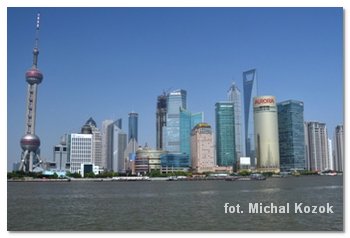 In my opinion the highlight, in terms of Shanghai architecture, is The Bund. It is Huangpu River waterfront promenade, which once was served as the main port. Next to it there is a range of stylish colonial buildings, but just behind them there are huge modern skyscrapers. If you walk a little farther south, you will find the old two-storey hutongs district, with narrow alleys full of street vendors and drying laundry. However, there is a city image just across the river - there are one of the highest buildings in the world. The most characteristic is the Oriental Pearl TV Tower and Tower Financial Center, currently the world's eight highest (492 m). Both buildings are accessible by lift, price depending on the floor level you want to get to (maximum of 100th floor for 150 Y). There are plenty of attractions around: aquariums, pedestrian under river
In my opinion the highlight, in terms of Shanghai architecture, is The Bund. It is Huangpu River waterfront promenade, which once was served as the main port. Next to it there is a range of stylish colonial buildings, but just behind them there are huge modern skyscrapers. If you walk a little farther south, you will find the old two-storey hutongs district, with narrow alleys full of street vendors and drying laundry. However, there is a city image just across the river - there are one of the highest buildings in the world. The most characteristic is the Oriental Pearl TV Tower and Tower Financial Center, currently the world's eight highest (492 m). Both buildings are accessible by lift, price depending on the floor level you want to get to (maximum of 100th floor for 150 Y). There are plenty of attractions around: aquariums, pedestrian under river 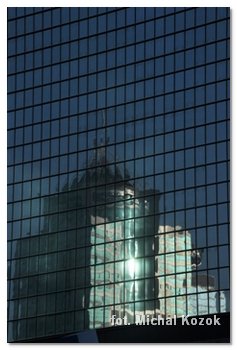 tunnel, parks, museums, markets, temples etc. But for us the temples looked far too artificial, and bazaars too modern, without a special atmosphere. For shopping souvenirs, traditional clothing and outdoor soft-shell or gore-tex jackets, I propose to go into the Fengxiang Plaza shopping mall, located at 580 Nanjing West Rd (intersection with Chengdu Rd) Vendors are very insistent - ignorance was the only helping solution. They usually demand the first price from 3 to 10 times higher than the product is worth - a ridiculously strong bargaining is compulsory.
tunnel, parks, museums, markets, temples etc. But for us the temples looked far too artificial, and bazaars too modern, without a special atmosphere. For shopping souvenirs, traditional clothing and outdoor soft-shell or gore-tex jackets, I propose to go into the Fengxiang Plaza shopping mall, located at 580 Nanjing West Rd (intersection with Chengdu Rd) Vendors are very insistent - ignorance was the only helping solution. They usually demand the first price from 3 to 10 times higher than the product is worth - a ridiculously strong bargaining is compulsory.
If you have an extra time in Shanghai, I recommend you to go to the ERA circus show. This is skill-acrobatic performance, but there is also some artistic setting. Actually, the whole design and choreography, perfect arrangement in time, sound (live singing and music), graceful transition from one show to another - those all create a unique atmosphere. Professionals perform there, during the two-hour show there is no time to be bored. I admired the guy balancing on the timber, skillful fat man playing with the huge porcelain vase, a beautiful play of gymnastics shadows, perfect acrobats, romantic air dancing on the ribbons, a crazy motorcycles ride etc. It was a revelation! Tickets starts from 80 yuan, all information on www.era-shanghai.com
![]()
Shandong Province
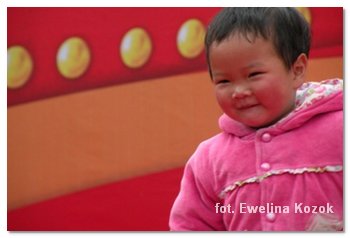
 Qufu is the place where Confucius lived and taught. Inside the old city, which is surrounded by high city wall, there is his temple and a house. Nearby is the cemetery, where the great scholar has his grave. Confucianism is more like social codes rather than religion. Its main aim is the acceptance of your role in the society, respect the father by his son, the husband by his wife, the ruler by his subordinates, etc. It is hard to believe that Chinese communist authorities did not support his teachings. This was, however, connected with his past, his links with feudal and imperial system. In 1948, after 2,500-year Kong rule in Qufu, the 77th generation Confucius son fled to Taiwan. Now the authority renewed his importance as a great scholar. And it is not, however, that they suddenly understood his ideology - the reason is prosaic – they can make money on it.
Qufu is the place where Confucius lived and taught. Inside the old city, which is surrounded by high city wall, there is his temple and a house. Nearby is the cemetery, where the great scholar has his grave. Confucianism is more like social codes rather than religion. Its main aim is the acceptance of your role in the society, respect the father by his son, the husband by his wife, the ruler by his subordinates, etc. It is hard to believe that Chinese communist authorities did not support his teachings. This was, however, connected with his past, his links with feudal and imperial system. In 1948, after 2,500-year Kong rule in Qufu, the 77th generation Confucius son fled to Taiwan. Now the authority renewed his importance as a great scholar. And it is not, however, that they suddenly understood his ideology - the reason is prosaic – they can make money on it. 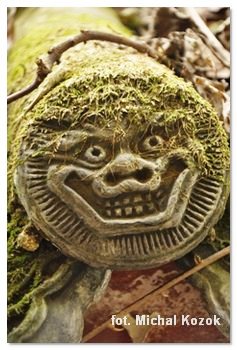
We decided to see his temple (Temple of Confucius, 90 Y). This is a reconstruction, a new artificial pavilions and minor concrete structures, recently made should looks old (on site authorities are still creating another "old" temples). After visiting so many places in China, it didn't surprise us. The only positive aspect of this temple is the park – the old real trees are growing there. After China's concrete reality I liked it, and even Chinese tourists appreciate this change. They photographed the trees and birds, even were sitting on the grass just to enjoy the clean natural environment. We even could smell the trees, we could relax (so, it's nothing extraordinary for western tourists).
After the disappointing temple, we decided not to visit the home of Confucius (Confucius Mansion, 60 Y). Same with his grave in an artificial park (Confucius Forest, 40 Y). But to save some money you can buy a combined ticket for all three sights (150 Y), which are open from 8 am to 5 pm.
 Tai Shan is one of the five Taoist's sacred mountains. I won't tell how the other sources are describing this sacred mountain with great words, because what happens in China nowadays – in my opinion it is only a commercial tourist trap. And I don't mind millions of visitors, but the commercialization of everything what possible. Even if you want to lit the scent stick in the temple, you have to pay, they treat it as attraction, nothing spiritual, the instructor will tell you through microphone what you should be doing (it is a show, where people are taking photos of “praying” friends members). The summit of the mountain looks like a bazaar, with street vendors and restaurant owners screaming through each other. The views from the top are okay, but nothing extraordinary.
Tai Shan is one of the five Taoist's sacred mountains. I won't tell how the other sources are describing this sacred mountain with great words, because what happens in China nowadays – in my opinion it is only a commercial tourist trap. And I don't mind millions of visitors, but the commercialization of everything what possible. Even if you want to lit the scent stick in the temple, you have to pay, they treat it as attraction, nothing spiritual, the instructor will tell you through microphone what you should be doing (it is a show, where people are taking photos of “praying” friends members). The summit of the mountain looks like a bazaar, with street vendors and restaurant owners screaming through each other. The views from the top are okay, but nothing extraordinary.
You can get to the top of the mountain first by bus, then by a cable car. For the more ambitious ones there are 6660 concrete stairs. I started climbing from the hostel next to the temple in the Tai'an city centre. I have chosen Central Route on the way to the top (entry fee normal/student 125/60 Y). The entire route has concrete stairs. In the middle of this trail there is Midway Gate to Heaven, a final stop for buses coming here from the town, and beginning of the cable car to the summit. However, if you decide to continue the climbing, it now remains only 600 meters difference in altitude. I was running to this point, since now I wasn't able to continue, 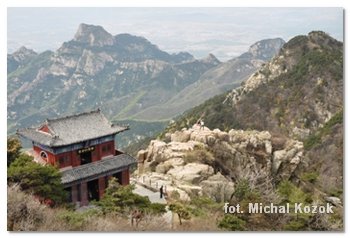 due to very steep slope. I walked fast instead, taking two stairs at one step. I was tired, but from the hotel to the top took me less than two hours – normally you should calculate at least twice longer.
due to very steep slope. I walked fast instead, taking two stairs at one step. I was tired, but from the hotel to the top took me less than two hours – normally you should calculate at least twice longer.
After I rested at the top of this commercial attraction, I started to descend. However, since the Midway Gate to Heaven I decided to continue my descend on the Western Route - it was a good choice, because suddenly I was alone, in silence and tranquility. Moments later, I walked on the forest path, not on the concrete stairs. The trail was sometimes a bit hard to find, so I walked as well on the paved bus road, and I tried again to take another forest shortcut. This is much longer route, but definitely more enjoyable and not so steep.